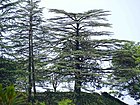Note: This is a project under development. The articles on this wiki are just being initiated and broadly incomplete. You can Help creating new pages.
Difference between revisions of "Cedrus deodara - Devadaru"
(Created page with "thumb|right|''Devadaru'', ''Cedrus deodara'' '''Devadaru''', is a very elegant ornamental tree, commonly found on the slopes of Weste...") |
(→Photo Gallery) |
||
| Line 66: | Line 66: | ||
==Photo Gallery== | ==Photo Gallery== | ||
<gallery class="left" caption="" widths="140px" heights="140px"> | <gallery class="left" caption="" widths="140px" heights="140px"> | ||
| − | + | ||
File:Cedrus deodara India16.jpg | File:Cedrus deodara India16.jpg | ||
File:Cedrus deodara Manali 4.jpg | File:Cedrus deodara Manali 4.jpg | ||
Revision as of 17:47, 17 April 2019
Devadaru, is a very elegant ornamental tree, commonly found on the slopes of Western Himalayas. It is a large evergreen coniferous tree reaching 40-50 m tall, exceptionally 60 m, with a trunk up to 3 m diameter. It has a conic crown with horizontal branches and drooping branchlets.
Contents
- 1 Uses
- 2 Parts Used
- 3 Chemical Composition
- 4 Common names
- 5 Properties
- 6 Habit
- 7 Identification
- 8 List of Ayurvedic medicine in which the herb is used
- 9 Where to get the saplings
- 10 Mode of Propagation
- 11 How to plant/cultivate
- 12 Commonly seen growing in areas
- 13 Photo Gallery
- 14 References
- 15 External Links
Uses
BLoating, Hiccups, Urinary tract disorders, diabetes, Inflammation [1]
Parts Used
Bark, Heartwood, Resin, Oil, Leaves
Chemical Composition
Common names
| Language | Common name |
|---|---|
| Kannada | bhadradaaru, daevadaaru |
| Hindi | devdar |
| Malayalam | devataram |
| Tamil | devadaram, devadaru, devadharam |
| Telugu | |
| Marathi | NA |
| Gujarathi | NA |
| Punjabi | NA |
| Kashmiri | NA |
| Sanskrit | amarataru, badradaru, bhadrakasta, suradruma, indravrksa |
| English | Devdar, Himalayan Cedar |
Properties
Reference: Dravya - Substance, Rasa - Taste, Guna - Qualities, Veerya - Potency, Vipaka - Post-digesion effect, Karma - Pharmacological activity, Prabhava - Therepeutics.
Dravya
Rasa
Tikta (Bitter), Katu (Pungent), Kashaya (Astringent)
Guna
Laghu (Light), Rooksha (Dry)
Veerya
Ushna (Hot)
Vipaka
Kapha, Vata
Prabhava
Habit
Identification
Leaf
| Kind | Shape | Feature |
|---|---|---|
| Needles | Needles blue-green, about 30 in a cluster, 3-5 cm long, acuminate |
Flower
| Type | Size | Color and composition | Stamen | More information |
|---|---|---|---|---|
| Unisexual | Male and female cones | Flowers appear in September and October. Cones solitary or in pairs. ovate or barrel-shaped. 7-10 cm long, 5-6 cm wide, rounded at the apex, bluish when young, reddish-brown when ripe; maturing from September to November |
Fruit
| Type | Size | Mass | Appearance | Seeds | More information |
|---|---|---|---|---|---|
| Cone | the seed is shed from scaly cones from September to December; seed scales 5-6 cm wide, usually glabrous on the upper side. Seed about 17 mm long, about 6 mm wide; wing large, light brown | {{{5}}} | {{{6}}} |
Other features
List of Ayurvedic medicine in which the herb is used
Where to get the saplings
Mode of Propagation
How to plant/cultivate
Season to grow
Soil type
Propagation
Commonly seen growing in areas
Photo Gallery
References
External Links
- Ayurvedic Herbs known to be helpful to treat BLoating
- Ayurvedic Herbs known to be helpful to treat Hiccups
- Ayurvedic Herbs known to be helpful to treat Urinary tract disorders
- Ayurvedic Herbs known to be helpful to treat diabetes
- Ayurvedic Herbs known to be helpful to treat Inflammation
- Herbs with Bark used in medicine
- Herbs with Heartwood used in medicine
- Herbs with Resin used in medicine
- Herbs with Oil used in medicine
- Herbs with Leaves used in medicine
- Herbs with common name in Kannada
- Herbs with common name in Hindi
- Herbs with common name in Malayalam
- Herbs with common name in Tamil
- Herbs with common name in Sanskrit
- Herbs with common name in English
- Habit - Tree
- Index of Plants which can be propagated by Seeds
- Herbs that are commonly seen in the region of Temperate area
- Herbs that are commonly seen in the region of Himalayas
- Herbs
- Himalayas
- Tree




